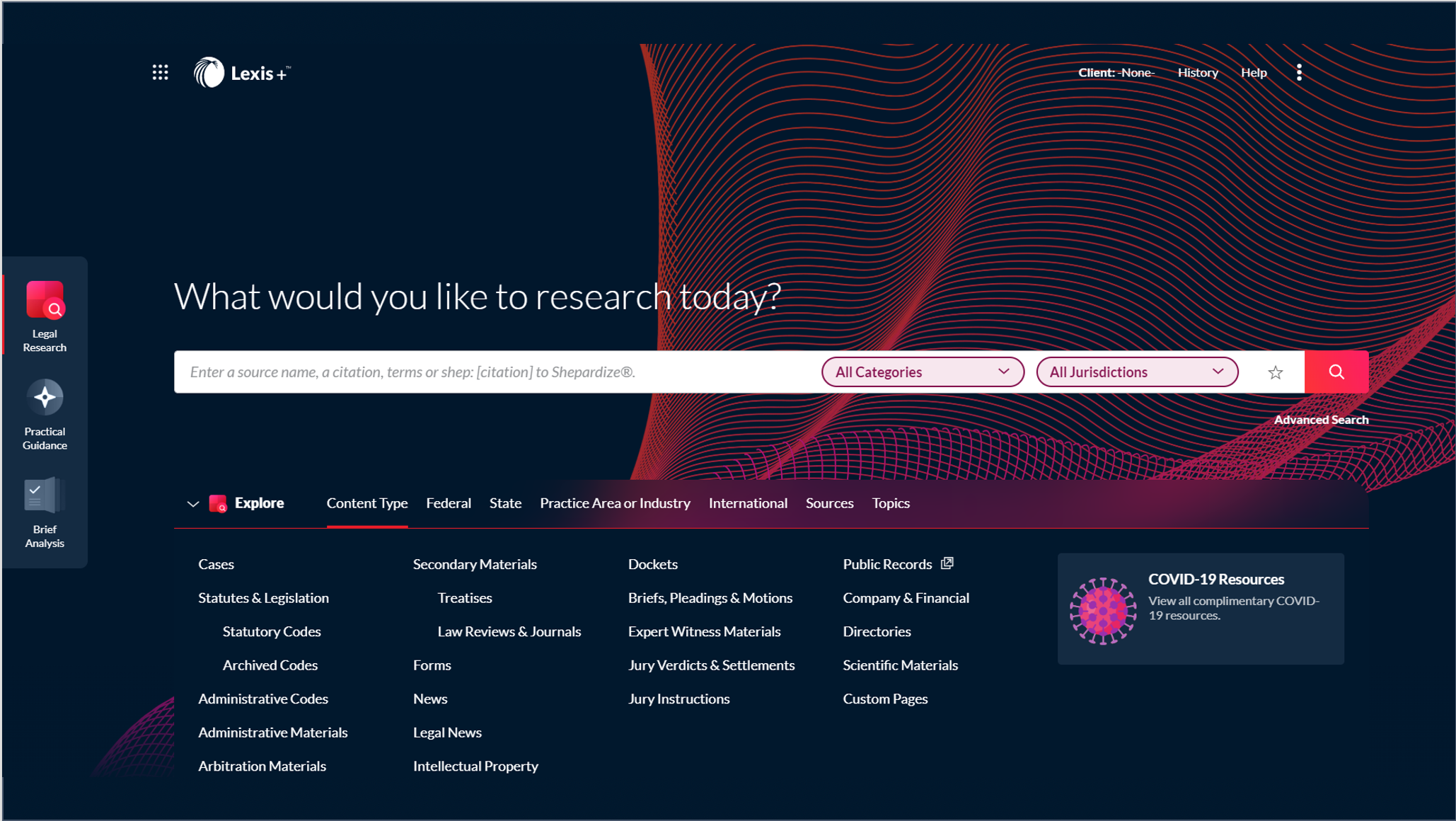LexisNexis is today announcing the launch of a premium legal research service, Lexis+, that it says takes a bold approach to providing legal research, AI-driven analytics and practical guidance within a unified and fully integrated platform.
The company is positioning this new service not as a successor to its current research platform, Lexis Advance, but rather as a higher-end alternative designed for users who want an all-in-one, end-to-end platform that incorporates the latest powerhouse technologies, including several that are unique to this product.
“There will be no phase-out of Advance in the near term,” Jeff Pfeifer, chief product officer, told me during a demonstration earlier this week. “We will see how the market embraces this new solution and then see how that impacts the longer-term life of Advance.”
While Lexis+ is built on the same platform as Lexis Advance, LexisNexis is positioning it as a “bold” and “dramatic” new research service, a theme it emphasizes through the the use of striking colors and imagery uncommon in a legal research platform, highlighted by what the company calls the “insight wave.” The purpose is not just to be visually engaging, but also to use typography and visual styling to establish a clear visual hierarchy and workflow.
But the changes are more than skin deep. Lexis+ incorporates many features that will be familiar to Lexis Advance users, but it also introduces new features and tools that are exclusive to this platform, including:
- “Reinvented” legal research, with new and enhanced features for conducting research and navigating results.
- Brief analysis, with the introduction of LexisNexis’s brief analysis tool.
- Revamped Practical Guidance, with tighter integration within the research workflow.
In the second half of the year, the product will be further enhanced with the integration of Lex Machina analytics, Courtlink, and other tools. Early in 2021, content from Law360 will be incorporated into the platform.
Initial access to Lexis+ is being rolled out this week exclusively to law school faculty members. In August, it will be provided to law students. The product will be made commercially available starting Sept. 1.
(The product was originally slated to be released at the annual conference of the American Association of Law Libraries, which is now a virtual conference starting Monday.)
During the demonstration with Pfeifer earlier this week, in which David Ganote, senior director of product planning, also participated, they told me that Lexis+ was the result of 18 months of development and extensive customer feedback, including some 2,000 direct customer interactions. The overarching goal, they said, was to fully unify legal research, Practical Guidance and brief analysis within a single product.
Legal Research
Research starts at the landing page, where the user can select from three “experiences,” as Lexis+ calls them: legal research, Practical Guidance and brief analysis.
LexisNexis says the search functionality in Lexis+ is designed to set “a precedent in simplicity” and to require virtually no learning curve, especially for anyone already experienced in using Lexis Advance.
At the same time, Pfeifer told me during our demonstration, the search tool is designed to balance two interests — making maximum use of artificial intelligence and machine learning capabilities while also allowing researchers to maintain the ability to control and customize their searches.
One way it does this is through a new feature called the Search Tree, which displays visually how the terms in a terms-and-connectors or Boolean search were applied and how those relationships impacted the results. (It does not work with natural language searches.) Whereas in Lexis Advance you would not know how your search terms were applied, in Lexis+ the Search Tree shows you.
In the Search Tree, each part of the search is represented in a box that displays how many results would be retrieved if only that part of the search was run. You can select any of the boxes to refresh the results with those search terms.
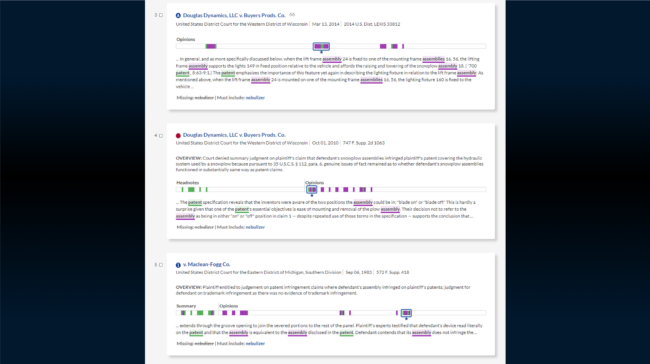
The Missing and Must Include feature highlights terms from your search query that are missing and lets you force their inclusion.
Another new feature to give users greater control is called Missing and Must Include. It highlights terms from your search query that are missing from a specific document in the results set, without having to open the document. When you see a “missing” term at the bottom of the search-results snippet, you can select “Must Include” to rerun the search and force inclusion of that term.
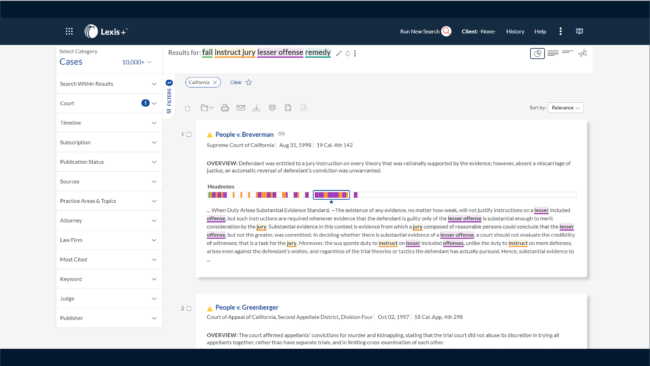
Search Term Maps show the location and distribution of your search terms.
Finally, Lexis+ expands the Search Term Maps feature of Lexis Advance from just case law to more than 30 content types, including news, statutes and legislation, administrative codes, secondary materials, administrative materials, and litigation documents.
These maps show the location and distribution of your search terms both within the results list and within the full text of documents. You can use this to identify where in a document are the largest concentrations of your search terms or to navigate to points in document where specific terms appear.
New Shepard’s At Risk
A new feature included within Lexis+ is Shepard’s At Risk. It identifies cases that are at risk of being overruled, even if they have not directly been. It flags cases in which the underlying points of law on which they rely have been negatively treated by other decisions in the same jurisdiction, which would suggest it is at risk.
This appears to be similar in concept to the enhanced citator Thomson Reuters introduced two years ago as part of its roll-out of Westlaw Edge, which likewise identified cases that may no longer be good law, even when there is no direct citation relationship between the case at hand and the case that possibly invalidated it.
In an example provided by LexisNexis, a Georgia case, Durrah v. State Farm Fire & Cas., 312 Ga. App. 49 (2011), shows up in Lexis+ with a red label, “At Risk,” even though the case has not directly been overruled or discussed negatively by other decisions. However, for a specific point of law, the case relies on another decision which has been overruled.
The At Risk feature highlights the text of the passage in question and displays alongside it that cases that give rise to the risk.
Lexis Answers
Pfeifer and Ganote said that Lexis Answers has been completely redesigned for Lexis+. It uses semantic analysis to understand the meaning of what you’re asking. In the demonstration, when a search query was entered regarding facial recognition software, Lexis Answers understood that to relate to the concept of biometric identifiers and returned results accordingly.
The idea of Lexis Answers is to provide on-point answers, with citable authority, to natural-language legal questions, without the researcher having to comb through extensive search results. When you enter a query in Lexis+, it returns the top four answers by default, which you can expand with a click to 10 answers.
Each answer displays text from the case that is relevant to the question, as well as the court where the case was decided, the date it was decided, and the citation. Click on the answer to go to the exact location within the case where the answer text is found.
Code Compare
Another feature included within Lexis+ is Code Compare. This allows a user to compare two versions of any state or federal statute — such as the current version and the immediate prior version — with additions shown in green and deletions shown in red.
When viewing a statute, you would use this feature by clicking on the compare versions button. By default, it will compare the most current version with the most recently archived version, but the user can select to compare any two versions.
As of today’s release, the ability to compare versions back in time will be limited, However, within 30 days, all prior versions back to 1991 will be available.
Brief Analysis
As I wrote in a column last year at Above the Law, for legal research, brief analysis is the new vogue. Following the 2016 launch by Casetext of its CARA brief-analysis tool, other legal research companies followed suit with tools of their own, including Thomson Reuters, which last year unveiled Quick Check, and Bloomberg Law, which released its Brief Analyzer in February.
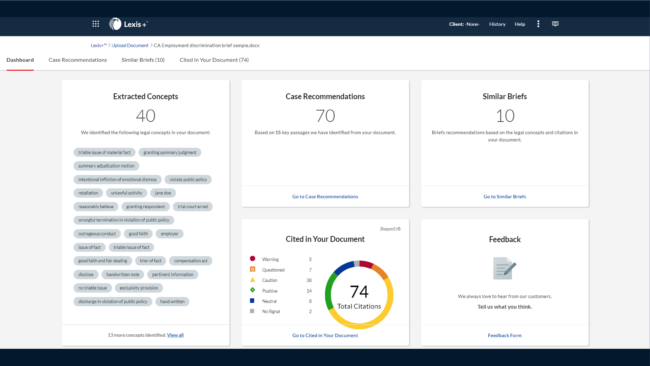
Now LexisNexis is releasing its brief-analysis tool, incorporated as a feature within Lexis+. Like other such tools, you upload a brief — your own or your opponent’s — and it analyzes the text to recommend cases you might have missed and briefs that you may wish to review as relevant to the brief’s legal arguments. It also performs a Shepard’s analysis of the cases cited in the document.
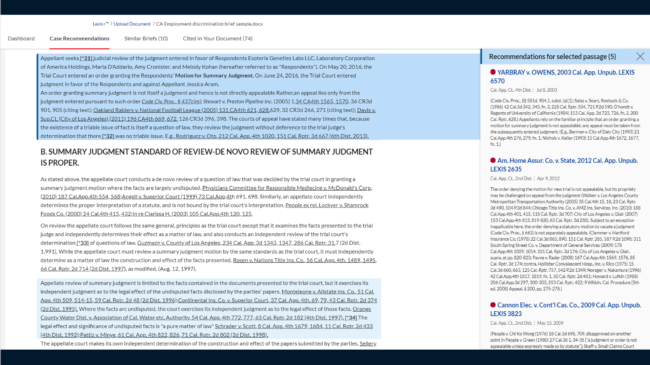
The analyzer shows its case recommendations inline with your brief, so that recommendations are displayed in the side panel adjacent to the paragraphs to which they relate. This lets you compare the recommended cases with the text of the brief to determine whether it accurately states the point of law.
The analyzer also points to other briefs that may be relevant to the one you are analyzing, highlighting matching legal concepts and cites for each of the recommended briefs.
In analyzing a brief, the tool extracts core legal and factual concepts and displays them on the left. In a future release, the user will be able to click any of these concepts to boost or reduce their influence on the case recommendations and recommended briefs.
Practical Guidance
LexisNexis Practical Guidance is a collection of practice-specific forms, clauses, checklists, articles and practice notes designed to help a legal professional get up to speed more quickly on a particular matter. All subscribers to Lexis+ will get access to one Practical Guidance collection and can add others as desired.
Pfeifer and Ganote said that Practical Guidance is fully integrated within Lexis+, incorporating all of its capabilities. To access Practical Guidance materials, you can select is as an “experience” from the home page, or start a search and select Practical Guidance results, or browse by practice area, content type or other parameters.
Searches of Practical Guidance lack the semantic analysis parsing that I described above for Lexis Answers, so a search for facial recognition might not pick up biometric identifiers. But Pfeifer said that will be developed for Practical Guidance in the second half of the year.
Pricing and Migration
As noted earlier, Lexis+ is initially being rolled out to law school faculty and students. It will become commercially available to all others on Sept. 1. LexisNexis has not yet set pricing for the product, although the actual cost will vary depending on the configuration a customer selects. The core product offering will include at least one Practical Guidance module and all the other features discussed above.
For those customers who would be migrating from Lexis Advance to Lexis+, Pfeiffer said the migration should be seamless. The product is built on the same core platform as Advance and was designed to be easy for anyone to use.
Bottom Line
Just as Thomson Reuters’ customers have a choice between classic Westlaw and the newer Westlaw Edge, LexisNexis customers will now be able to choose between Lexis Advance and Lexis+.
Pfeifer said that the development of Lexis+ was driven in part by customers’ pleas for legal research products that look more like consumer technology products, with better design and a better user experience.
It was also intended to address what Pfeifer described as the double-edged sword of machine learning technology in legal research — delivering smarter results but at the expense of user control. Lexis+ tries to balance advanced search with user control.
The overarching goal, Pfeifer said, was to create deep integration across the three products of research, Practical Guidance and brief analysis, to produce what he described as “a deeply complementary and integrated product experience.”
Having not yet been hands-on with Lexis+, I can say only that, based on the demonstration, it certainly has a compelling design and introduces a number of useful features. The platform will likely be much more compelling once it integrates other core LexisNexis products such as Lex Machina, CourtLink, and Law360.
All of that said, I have to wonder what customers will think, as they are asked to choose between competing legal research platforms from the same company (just as Thomson Reuters’ customers have had to do).
At no point during our demonstration did anyone describe this as the company’s next-generation research platform, but it sure seems that’s what it is. As such, it appears to be a strong start. The question for many customers will be whether and when to switch.
 Robert Ambrogi Blog
Robert Ambrogi Blog